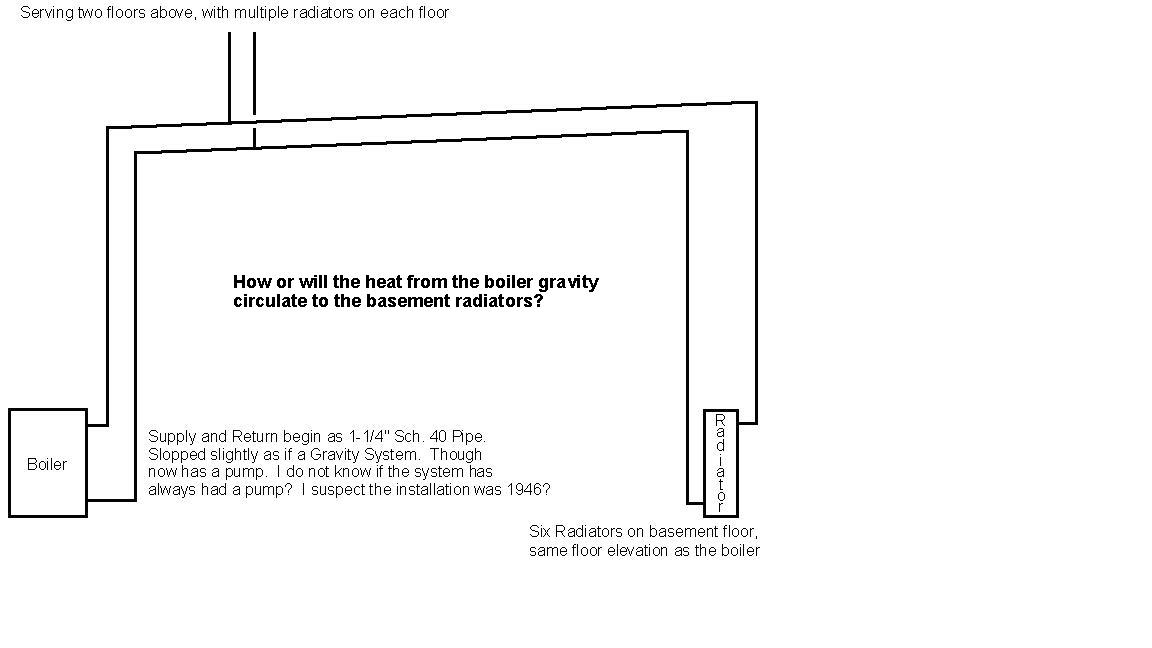Welcome! Here are the website rules, as well as some tips for using this forum.
Need to contact us? Visit https://heatinghelp.com/contact-us/.
Click here to Find a Contractor in your area.
If our community has helped you, please consider making a contribution to support this website. Thanks!
Gravity Boiler System
Options
Interestedtolearn
Member Posts: 4
Comments
-
Will not heat on gravity, must use a circulator.0
-
Hot water will not fall to the radiator. The piping you show is called a heat trap. Only forced circulation will make hot water move downward to emitters.Serving Northern Maine HVAC & Controls. I burn wood, it smells good!0
-
If the return to the boiler from those rads went under the floor then there might be some gravity flow. I have seen this in an old house but they wanted the basement rads removed as there was enough heat from the boiler in the basement.0
-
-
Your replies are appreciated! From what I knew / understood, I was not comprehending how such an installation would work by gravity for the basement? You confirmed my suspicion/s! Now my question is:
1. With six cast iron free standing radiators in the basement.
2. With three cast iron free standing radiators and five baseboard radiators (4', 10', 10', 2' & 2') on the main floor
3. With four cast iron free standing radiators on the top (third floor)
What size pump (how many gpm?) would likely be the most appropriate?0 -
Pump sizing depends heavily on the diameter of the pipes conveying water in the system, and the total "round trip" length of those pipes.Hydronics inspired homeowner with self-designed high efficiency low temperature baseboard system and professionally installed mod-con boiler with indirect DHW. My system design thread: http://forum.heatinghelp.com/discussion/154385
System Photo: https://us.v-cdn.net/5021738/uploads/FileUpload/79/451e1f19a1e5b345e0951fbe1ff6ca.jpg0 -
-
JUGHNE, to the best of my knowledge, all of the free standing radiators and baseboard heaters are all original. The diameter of the largest pipes and obviously reducing down while extending away from the boiler, and subsequently 'enlarging' while returning back to the boiler is 1-1/4" Sch. 40 Steel Pipe. The longest run (through the piping path, is roughly fifty feet of 'supply' piping, with the expected fifty feet of 'return' piping. All of the free standing radiators have half inch Sch. 40 steel pipe connecting to them. Any helpful information that can be provided regarding properly sizing a circulation pump for this installation would be appreciated.0
-
Not a gravity system with all 1/2" radiator runouts. This would have had a circulator from the get-go. I doubt even the "accelerated gravity" systems (think Honeywell heat Generator) used pipes that small.All Steamed Up, Inc.
Towson, MD, USA
Steam, Vapor & Hot-Water Heating Specialists
Oil & Gas Burner Service
Consulting1 -
With the piping layout you posted a diagram of, and what @Steamhead said, it sounds like you have a typical circulated hot water system.
Some pictures of the actual boiler, it's piping, and some of the T's that go to the radiators, as well as the radiators themselves would be helpful. Just to be sure you don't have a monoflow which would be typical for an older water system. You may have a simple direct return, or a reverse return. How you describe the pipe diameters getting subsequently smaller sounds like a direct return.
Can you diagram the system piping?Serving Northern Maine HVAC & Controls. I burn wood, it smells good!0 -
Solid_Fuel_Man, I am well acquainted with Monoflow tees & such systems. Also, the boiler has been removed and disposed of (neither by me). The customer has not chose a replacement boiler. However, regardless of the boiler chosen, I presume an appropriately sized circulation pump will be necessary. And I would like to be ahead of the game. I could provide a "system piping" diagram. However the above diagram is an accurate representation (of less detail of course). If a "system piping" diagram is truly necessary, I could provide one. If such is the case, how detailed would you like? Pipe Diameters, Pipe Lengths, Fitting Type/s / Sizes, etc... please confirm?0
-
In order to size a circ "poperly" you need to calculate the head loss of the piping, and fittings to the farthest convector, and back from the circulator. This involves pipe diameters, lengths, and developed length of all fittings in that circuit.
If the circulator is sized to the highest head loss circuit (usually the farthest one) the other circuits will be fine.1
Categories
- All Categories
- 87.4K THE MAIN WALL
- 3.2K A-C, Heat Pumps & Refrigeration
- 61 Biomass
- 429 Carbon Monoxide Awareness
- 120 Chimneys & Flues
- 2.1K Domestic Hot Water
- 5.8K Gas Heating
- 115 Geothermal
- 168 Indoor-Air Quality
- 3.7K Oil Heating
- 77 Pipe Deterioration
- 1K Plumbing
- 6.5K Radiant Heating
- 395 Solar
- 15.7K Strictly Steam
- 3.4K Thermostats and Controls
- 56 Water Quality
- 51 Industry Classes
- 50 Job Opportunities
- 18 Recall Announcements


